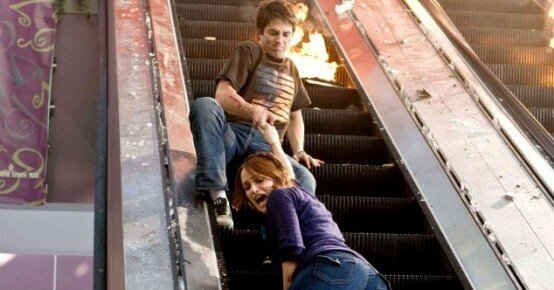Predictability. It’s something that tends to plague many films, yet it’s the single greatest strength of the Final Destination series. There’s nothing more predictable than someone dying in a horror film, so why not embrace it? It’s all about the build-up; knowing something bad is going to happen, but being powerless to stop it, is more nerve wrecking than the actual event itself. That’s why the Final Destination series actually benefits from foreshadowing everything to, ahem, death.
That being said, The Final Destination – the confusingly labelled fourth instalment in the series — embraces predictability perhaps a bit too much. Just like each prior instalment, the narrative structure is essentially a carbon copy of the first film. It’s a case of don’t fix what ain’t broke (just add 3D!), but it’s also a sign of lazy screenwriting.
The formula goes something like this; a group of young, attractive Americans evade death because one of them vividly foresaw their doom moments prior (why exactly? We never find out). This time it’s a college student Nick (Bobby Campo) with the premonition, who escapes death with his girlfriend Lori (Shantel VanSanten), her friend Janet (Haley Webb) and Janet’s egotistical boyfriend Hunt (Nick Zano), along with a few others. Death isn’t at all pleased by this, and decides to hunt them down one by one – in the order they were supposed to die in the disaster – by means of gruesome freak “accidents”.
![final_destination_4_04[1] final destination 4 041 350x233 The Final Destination 3D (Review)](/wp-content/uploads/final_destination_4_041-350x233.jpg)
|
Each character is little more than a pincushion devoid of personality, mostly characterised by how they eventually die rather than how they lived. It’s not too detrimental to the overall enjoyment of the film because, much like the traps in the Saw films, it’s the creativity and choreography of their deaths that keeps us engaged. I wont give too much away about how each character meets their doom, but I will say this; the film has justified my deep fear of drive-in car washes. Those things seriously freak me out.
The highlight of each film in the series has always been the opening disaster sequence. The first featured a mid-air plane explosion, the second was a highway pileup (by far the best) and the third was a rollercoaster derailment. In the forth, a colossal NASCAR crash causes debris to fly into the spectator stands, ultimately causing the roof of the stadium to collapse. While director David R. Ellis (Final Destination 2) captures the carnage well, it’s the weakest of the series so far, which probably has to do with the fact that I can relate to planes, highways and rollercoasters more than I can motorsports (particularly since we don’t have NASCAR in Australia).
The only thing drastically different about this Final Destination is the addition of 3D, which sees all manner of objects – tyres, nails, glass, planks and even snakes – fly at our faces. I’ve preached about this before, but I’m still not sold on the technology. Not only does it see the frame rate suffer – a bit like watching a video buffer online – I’m yet to see a live action film utilise it without drawing undue attention to sloppy 3D renders. That being said, the extra dimension does add an immersive depth to some of the shots, which is where I hope the focus of the technology will rest in the future.
It’s easy to pull apart a film like The Final Destination for its sloppy screenplay, limp performances and bloodthirsty premise. But as a thriller, it’s damn effective. It had me sitting anxiously on the edge of my seat, knuckles whitened, not because of a gory death, but because of the suspenseful build up to one. Few other films within the horror genre have had that effect.
Verdict:
The Final Destination might be the same ride we’ve ridden three times before, but I’m having too much fun to get off just yet.
 Follow the author Anders Wotzke on Twitter.
Follow the author Anders Wotzke on Twitter.
















